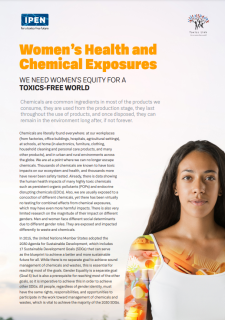
This factsheet presents the issue of women and chemicals, which needs more scientific and policy attention. Chemicals are common ingredients in most products consumed. They are used from the production stage, they last throughout the use of products, and once disposed, they can remain in the environment long after, if not forever.
Women are especially susceptible to chemical exposure and health outcomes primarily because of their physiology, biological makeup, types of occupational exposures, exposures to chemicals in personal care and household products, and their social situations. To deal with this critical issue, the document emphasizes to take into account some key action points, including women’s equal participation in chemicals management and the need to prioritize the protection of women as a group highly susceptible to adverse effects from chemical exposure.
Target audience
- Stockholm Convention Official Contact Points and National Focal Points, particularly from project countries
- National officials and experts involved in the process of reviewing and updating the NIPs
- National officials and experts involved in hazardous chemicals and waste management
- Members of NIP National Coordinating Mechanism/Committees and Project Coordination Units/Thematic Task Groups
- Representatives of regional centres
- Other stakeholders
As part of the GEF-funded and UNEP-led “Global Development, Review and Update of NIPs under the Stockholm Convention on POPs” project, the Green Growth Knowledge Partnership (GGKP) is executing Component 4, focused on disseminating information, managing knowledge and coordinating with the Stockholm Convention Secretariat to provide accessible, integrated tools and resources for all Parties.
